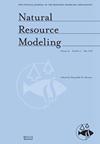A regional analysis of climate change effects on global snow crab fishery
IF 2.1
4区 环境科学与生态学
Q3 ENVIRONMENTAL SCIENCES
引用次数: 0
Abstract
The snow crab fishery faces increasing vulnerability to environmental factors, yet the literature on the relationship between climate change and snow crab harvest remains limited. This study estimates snow crab harvest functions using climate change indicators with unbalanced panel data of snow crab production from the eastern Bering Sea (Alaska), the southern Gulf of St. Lawrence (Canada), the Sea of Japan, and the Barents Sea (Norway‐Russia). The relationship between snow crab biomass, stock, and catch is analyzed and the endogeneity of stock in the harvest function is also addressed using climate change indicators as instrumental variables (IVs). The results show that the extent of Arctic sea ice is effective in addressing the endogeneity, and the random effects IV model with error components two stage least squares estimator performs the best to control heterogeneity. A 1% increase in snow crab fishing effort is associated with a 0.42% increase in snow crab harvest, and a 1% increase in snow crab stock causes a 0.98% increase in snow crab harvest. The reported estimates indicate a large stock‐harvest elasticity and provide supporting evidence to prioritize stock enhancement in snow crab fishery policy designs to maintain stocks at sustainable levels and minimize government expenditures on subsidies.Recommendations气候变化对全球雪蟹渔业影响的区域分析
雪蟹渔业越来越容易受到环境因素的影响,但有关气候变化与雪蟹收获量之间关系的文献仍然有限。本研究利用白令海东部(阿拉斯加)、圣劳伦斯湾南部(加拿大)、日本海和巴伦支海(挪威-俄罗斯)的雪蟹产量非平衡面板数据,利用气候变化指标估算雪蟹收获函数。研究分析了雪蟹生物量、种群和渔获量之间的关系,并利用气候变化指标作为工具变量(IV),解决了收获函数中种群的内生性问题。结果表明,北极海冰范围能有效地解决内生性问题,随机效应 IV 模型与误差分量两阶段最小二乘估计器在控制异质性方面表现最佳。雪蟹捕捞量每增加 1%,雪蟹收获量就会增加 0.42%;雪蟹种群每增加 1%,雪蟹收获量就会增加 0.98%。报告的估计结果表明种群-捕捞弹性很大,为在雪蟹渔业政策设计中优先考虑种群增殖提供了支持性证据,以将种群维持在可持续水平,并最大限度地减少政府的补贴支出。 本研究探讨了在全球变暖的背景下,雪蟹捕捞量如何受到全球不同地区雪蟹种群和捕捞努力量的影响,包括白令海、圣劳伦斯湾、日本海和巴伦支海。捕捞量增加 1%,收获量增加 0.42%,而雪蟹种群增加 1%,收获量增加 0.98%,显示出对雪蟹生物量的高度依赖性。北极海冰范围被认为是影响雪蟹生物量和收获量的一个关键气候因素,使其成为了解和管理雪蟹种群的一个有价值的变量。该研究支持渔业机构优先制定种群增殖政策,并建议对不同地区的捕捞努力量进行标准化测量,以改善雪蟹渔业管理和未来研究。
本文章由计算机程序翻译,如有差异,请以英文原文为准。
求助全文
约1分钟内获得全文
求助全文
来源期刊

Natural Resource Modeling
环境科学-环境科学
CiteScore
3.50
自引率
6.20%
发文量
28
审稿时长
>36 weeks
期刊介绍:
Natural Resource Modeling is an international journal devoted to mathematical modeling of natural resource systems. It reflects the conceptual and methodological core that is common to model building throughout disciplines including such fields as forestry, fisheries, economics and ecology. This core draws upon the analytical and methodological apparatus of mathematics, statistics, and scientific computing.
 求助内容:
求助内容: 应助结果提醒方式:
应助结果提醒方式:


